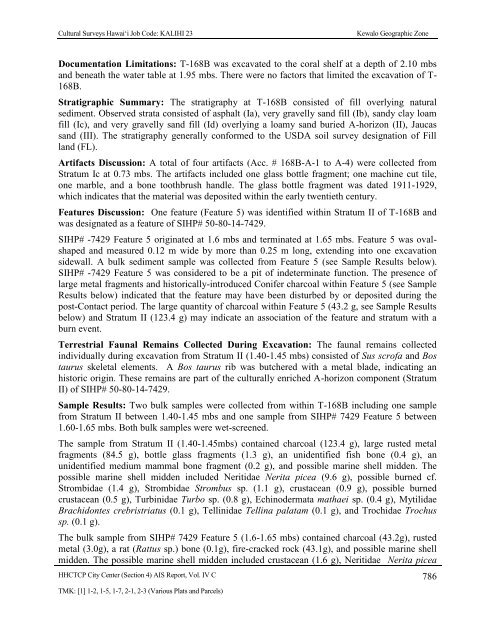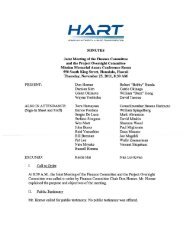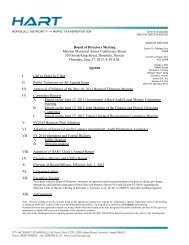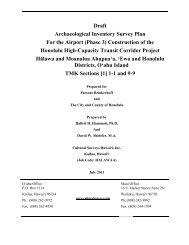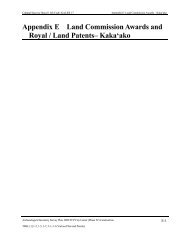4.12 Test Excavation 167 (T-167) - Honolulu Rail Transit Project
4.12 Test Excavation 167 (T-167) - Honolulu Rail Transit Project
4.12 Test Excavation 167 (T-167) - Honolulu Rail Transit Project
You also want an ePaper? Increase the reach of your titles
YUMPU automatically turns print PDFs into web optimized ePapers that Google loves.
Cultural Surveys Hawai‘i Job Code: KALIHI 23Kewalo Geographic ZoneDocumentation Limitations: T-168B was excavated to the coral shelf at a depth of 2.10 mbsand beneath the water table at 1.95 mbs. There were no factors that limited the excavation of T-168B.Stratigraphic Summary: The stratigraphy at T-168B consisted of fill overlying naturalsediment. Observed strata consisted of asphalt (Ia), very gravelly sand fill (Ib), sandy clay loamfill (Ic), and very gravelly sand fill (Id) overlying a loamy sand buried A-horizon (II), Jaucassand (III). The stratigraphy generally conformed to the USDA soil survey designation of Fillland (FL).Artifacts Discussion: A total of four artifacts (Acc. # 168B-A-1 to A-4) were collected fromStratum Ic at 0.73 mbs. The artifacts included one glass bottle fragment; one machine cut tile,one marble, and a bone toothbrush handle. The glass bottle fragment was dated 1911-1929,which indicates that the material was deposited within the early twentieth century.Features Discussion: One feature (Feature 5) was identified within Stratum II of T-168B andwas designated as a feature of SIHP# 50-80-14-7429.SIHP# -7429 Feature 5 originated at 1.6 mbs and terminated at 1.65 mbs. Feature 5 was ovalshapedand measured 0.12 m wide by more than 0.25 m long, extending into one excavationsidewall. A bulk sediment sample was collected from Feature 5 (see Sample Results below).SIHP# -7429 Feature 5 was considered to be a pit of indeterminate function. The presence oflarge metal fragments and historically-introduced Conifer charcoal within Feature 5 (see SampleResults below) indicated that the feature may have been disturbed by or deposited during thepost-Contact period. The large quantity of charcoal within Feature 5 (43.2 g, see Sample Resultsbelow) and Stratum II (123.4 g) may indicate an association of the feature and stratum with aburn event.Terrestrial Faunal Remains Collected During <strong>Excavation</strong>: The faunal remains collectedindividually during excavation from Stratum II (1.40-1.45 mbs) consisted of Sus scrofa and Bostaurus skeletal elements. A Bos taurus rib was butchered with a metal blade, indicating anhistoric origin. These remains are part of the culturally enriched A-horizon component (StratumII) of SIHP# 50-80-14-7429.Sample Results: Two bulk samples were collected from within T-168B including one samplefrom Stratum II between 1.40-1.45 mbs and one sample from SIHP# 7429 Feature 5 between1.60-1.65 mbs. Both bulk samples were wet-screened.The sample from Stratum II (1.40-1.45mbs) contained charcoal (123.4 g), large rusted metalfragments (84.5 g), bottle glass fragments (1.3 g), an unidentified fish bone (0.4 g), anunidentified medium mammal bone fragment (0.2 g), and possible marine shell midden. Thepossible marine shell midden included Neritidae Nerita picea (9.6 g), possible burned cf.Strombidae (1.4 g), Strombidae Strombus sp. (1.1 g), crustacean (0.9 g), possible burnedcrustacean (0.5 g), Turbinidae Turbo sp. (0.8 g), Echinodermata mathaei sp. (0.4 g), MytilidaeBrachidontes crebristriatus (0.1 g), Tellinidae Tellina palatam (0.1 g), and Trochidae Trochussp. (0.1 g).The bulk sample from SIHP# 7429 Feature 5 (1.6-1.65 mbs) contained charcoal (43.2g), rustedmetal (3.0g), a rat (Rattus sp.) bone (0.1g), fire-cracked rock (43.1g), and possible marine shellmidden. The possible marine shell midden included crustacean (1.6 g), Neritidae Nerita piceaHHCTCP City Center (Section 4) AIS Report, Vol. IV C 786TMK: [1] 1-2, 1-5, 1-7, 2-1, 2-3 (Various Plats and Parcels)


